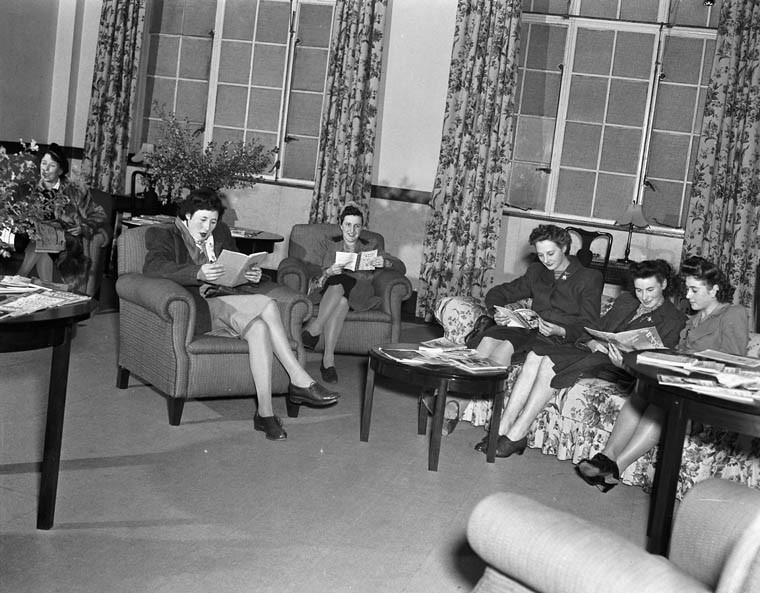Anna Gaudet currently works as a genealogical researcher and library assistant at the Canadian Museum of Immigration at Pier 21. Her MA in History (McGill University, 2023) was supported by the McCall MacBain graduate scholarship. You can read her article in the Journal of the Canadian Historical Association / Revue de la Société historique du Canada, vol. 35, no. 1 (2025) by clicking here.
How did the Canadian state use the concept of national identity to differentiate itself from Britain while still promoting British war brides as ideal citizens?
The relationship between “Britishness” and “Canadianness” was an important element of my research. It was clear that there was a desire to create a model of war bride, and this is where we can see the concept of Canadian identity being used to differentiate Canada from the United Kingdom in a gendered way. Specifically, some of the documents provided to war brides use “homeland” to signify Canada and “the old land” to signify the UK, bridging yet dividing the two countries by virtue of their shared ancestry and cultural traditions. This process carries over into materials about Canadian foodways and consumerism. These documents often present an idea of old world scarcity in the United Kingdom and new world plenty in Canada. By differentiating the UK from Canada as the old and the new, the wartime and the postwar, the social, political and even nationalist elements of these women’s Britishness could be ontologically separated from their (and Canada’s) shiny new postwar identity. This can be seen in the stylish design of the Canadian Wives’ Club, an oasis full of locally crafted furniture, paintings by Canadian artists, and Eaton’s catalogues located in the centre of war-ravaged downtown London.

Canadian Wives Bureau, View of Lounge.
Source: Photograph by Charles H. Richer, November 30, 1944. Library and Archives Canada, Department of National Defence Fonds, http://central.bac-lac.gc.ca/.redirect?app=fonandcol&id=3210427&lang=eng.
What messages about gender roles and expectations were conveyed through the language and imagery used in Welcome to War Brides and the Canadian Cookbook for British Brides?
In short, there was an association in these texts between “good citizenship” and the British war brides’ role as consumerist homemakers, subordinate yet supportive wives, and demonstrative, moral mothers. For example, the language used in Welcome to War Brides discursively intertwines the concepts of citizenship and assimilation with the roles of wife and mother. The idea of conformity is operationalized in the form of “secrets to success” for a Canadian’s wife. Gendered language separated spheres of activity in the home and the term “Canadian children” was used quite often, despite the fact that many war brides had brought with them British-born children. The Canadian Cookbook for British War Brides frames familiarizing oneself with Canadian ways of life as familiarizing oneself with the kitchen and the grocery store. The booklet describes kitchen utensils as “tools of your trade” and stresses the importance of satisfying your husband with your cooking. It is interesting to see the moral weight assigned to fulfilling certain postwar gender roles and expectations in these materials.
What was the general reception of British war brides to Canada?
I find it difficult to find a general mood to the reception of British war brides in Canada. Reading memoires and oral histories revealed how truly unique each war bride experience was. In my research, I discuss how their reception hinged on contemporary attitudes towards their ethnicity and gender. The Canadian state largely viewed British war brides as a welcome group for the purposes of nation building. This occurred on both a political and bureaucratic level. Throughout 1945 and 1946, public performances recognizing the arrival of war brides were commonplace. Documents associated with the war bride “repatriation” project outline how British war brides were an exceptionally attractive migrant class who ought to receive special treatment. Newspapers from across the country reported on the arrival of each ship carrying war brides and published complimentary profiles on specific women.
Most of this giddiness stemmed from the war brides’ Britishness. Their femininity was met with more criticism. Newspaper editorials capture contemporary anxieties about the number of overseas marriages, questioning their legitimacy. Some women complained they were met with “cattiness” from their in-laws. Government officials worried that expedited romances would perpetuate the spread of venereal disease and burden Canada’s social welfare system should these women seek a divorce after immigrating. Essentially, across all these groups there was an element of “meaning-making” happening, but that process seemed to depend on the perception of British war brides as British or brides.
Do you know how British war brides felt about these booklets?
This is something that I had a hard time parsing out in my research. I did find that courses and lectures presented by the Canadian Wives Bureau were both highly requested by British war brides and highly attended. Contemporary newspaper articles suggest some women wanted to surprise their husband or in-laws with their knowledge of Canada. Others seemed excited to assimilate. Scrolling through microfilms, I found that many women wrote to the Canadian Wives Bureau’s Information and Welfare Section to specifically request information about Canadian ways of life. Booklets such as Welcome to War Brides were created to cut down on the number of inquiries. There was certainly a demand for information. Exploring oral histories could provide more insight into how war brides interpreted this process themselves.
Have you read anything good recently?
I did lots of fiction reading during the summer months, and I have also been doing some excellent listening in the realm of history. I’ve recently dived into Project 1933, a podcast series presented by the incredible researcher and professor Adrian Daub of In Bed with the Right. Daub and his cohost writer Moira Donegan have been examining Adolf Hitler’s 1933 rise to power in great detail, unpacking it day by day. Importantly, the researchers have consulted a wide range of sources to discuss how people were feeling in 1933. Diary passages and oral histories are painting an incredible picture of how retrospective distortion changes the ways we think certain historical events were experienced. I can’t wait for future episodes.
